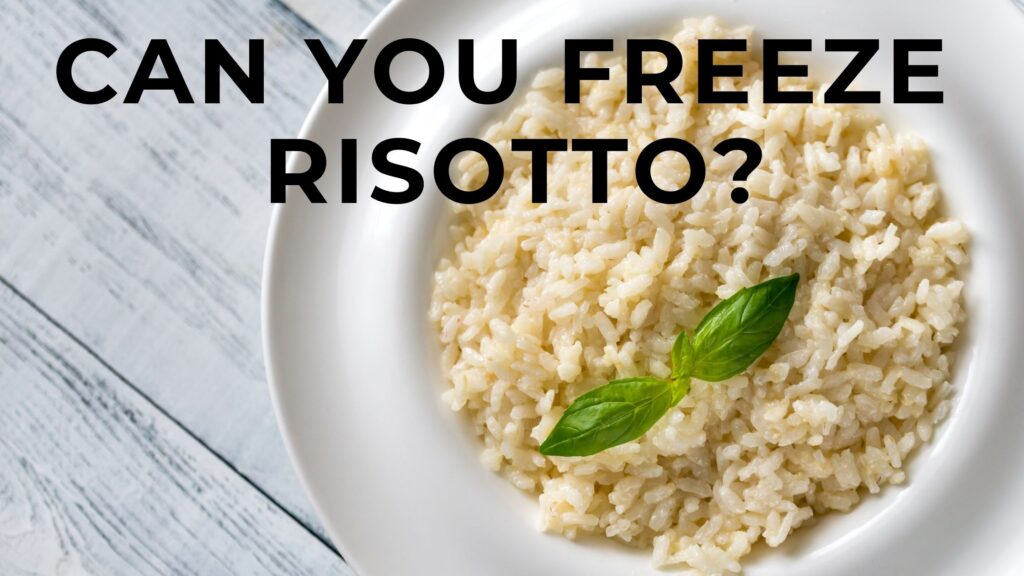Making risotto is a labor of love. It’s a dish that takes some time to make, but the result is worth it. The problem is, sometimes you might not have enough people around to eat all of the risotto that you made. Or maybe you made too much and don’t want it to go wrong. What can you do? You can freeze risotto! This blog post will explain how to freeze risotto and the pros and cons.

Can you freeze Risotto?
The answer is
Yes, you can freeze risotto. Risotto is a dish made with rice, and like most rice dishes, it freezes well. However, there will be a slight change in texture after defrosting and heating.
It’s important to remember a few things when freezing risotto.
First, the risotto should be cooled completely before being frozen. It will not freeze properly if you try to freeze hot risotto and turn into a mushy mess.
Second, you should freeze risotto in an airtight container. It will help it to retain its flavor and texture.
Once you have cooled and stored your risotto correctly, it will last in the freezer for three months. You can freeze it for longer, but the taste and texture will deteriorate with time.
How to freeze risotto?
There are a few ways to freeze. I recommend portioning the risotto according to the amount you can use in one go. Unfortunately, you cannot refreeze the leftover risotto after defrosting.
Here are the steps you need to freeze risotto:
- First, let the risotto cool completely.
- Place the cooled risotto in an airtight container or freezer bag, removing as much air as possible.
- Label and date the container or bag.
- Place in the freezer for up to six months.
Always label your freezer bags or containers. I prefer to freeze the risotto in airtight containers and small portions. It helps in thawing only the required amount of risotto.
How to defrost risotto?
There are a couple of ways you can defrost risotto.
In the fridge: The first is to place the frozen risotto in the refrigerator overnight. Then, if you know that you will need risotto the next day for dinner, put it in the fridge before bed. By morning, it will have thawed, and you can reheat it for dinner.
On the stove: The second way is to defrost the risotto on the stove. It is my preferred method as I can thaw and heat the risotto together. Add the frozen risotto to the pan and start heating on a low flame for this method.
Stir it occasionally and mix once the upper layer is melted. Stirring helps in keeping it from burning.
In the microwave: If you are in a hurry, you can use the microwave to defrost risotto. I do not recommend this method because it makes the risotto mushy. But if you are in a hurry, here is how you can do it:
- Place the frozen risotto in a microwave-safe dish.
- Add a little water, just enough to cover the bottom of the container.
- Cover with a lid or plastic wrap and microwave on low in 30-second intervals, stirring until thawed.
- Once defrosted, reheat the risotto on the stove over low heat until warm or heated to the required temperature.
The Pros and Cons of freezing risotto
Now that we know how to freeze and defrost risotto, let’s look at the pros and cons.
- Freezing risotto is a great way to save time. If you make a big batch of risotto, you can portion it out and freeze it for future meals. It means that you can have a delicious meal without spending the time making it from scratch.
2. Another advantage of freezing risotto is that it allows you to make a big batch and have leftovers for a later date. It is excellent if you are entertaining guests and want to have some risotto ready to go.
The only downside of freezing risotto is that it can change the texture slightly. When defrosting and reheating, the risotto may be more watery than the fresh one.
Despite this slight change in texture, freezing risotto is a great way to save time and have delicious meals on hand. So go ahead and give it a try!
Tips for defrosting risotto
If you want to maintain the taste of risotto, here are a few things to keep in mind while defrosting and reheating.
- Do not refreeze the leftover defrosted risotto.
- Label and date the container or bag before freezing.
- Place the frozen risotto in the refrigerator overnight to thaw it slowly.
- Stir while reheating on the stove over low heat.
- Add a little water, just enough to cover the bottom of the dish, when reheating in the microwave.
- Cover with a lid or plastic wrap while reheating in the microwave.
- Reheat in 30-second intervals, stirring until thawed.
